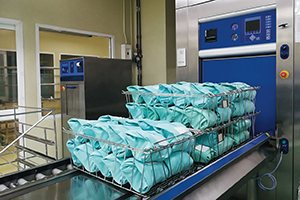COVID-19 spurred a spike in hospital-acquired infections, so hospitals return to infection-prevention basics
The abrupt start of the pandemic in early 2020 produced ripple effects throughout healthcare, including a lockstep increase nationwide in hospital-acquired infections (HAIs) related to factors surrounding COVID-19 treatment. Nearly two years later, healthcare experts are diligently working to restore lower HAI rates, analyzing lessons learned, and—with eyes wide open—preparing for future pandemics.
A study published in September 2021 by the U.S. Centers for Disease Control and Prevention (CDC) found the pandemic triggered a significant resurgence of several types of HAIs, including central-line associated bloodstream infections (CLABSIs), catheter-associated urinary tract infections (CAUTIs), ventilator-associated events (VAEs) and methicillin-resistant Staphylococcus aureus (MRSA) bacteremia.

While stunning to witness, such HAI increases were frustratingly predictable due to COVID treatments relying on medical devices such as ventilators and catheters, experts say. Still, additional insights will continue to materialize over the coming months and years, says Stephanie Thompson, PharmD, MBA, AVP, Clinical Services at HealthTrust.
“There were so many variables. It will be fascinating to watch the research as they unpack why,” Thompson says. “This pandemic has created a new way of viewing things because it impacted everything from the hospital front door to the most critical of patients. The interdependence amongst one another, that need for collaboration, has really been called out.”
A frustrating resurgence
The CDC findings were based on national and state-level hospital infection ratios calculated for each quarter of 2020 and compared to those from 2019. In the first quarter of 2020, HAI incidence was generally dropping compared to the same period a year earlier, but this trend shifted with the start of the pandemic.
The most significant year-over-year increase—of 47%—was seen in CLABSIs in late 2020. VAEs climbed by nearly 45% in the same period, likely reflecting increased ventilator usage, while MRSA bacteremia rose by nearly 34% and CAUTIs by almost 19%.
The resurgence proved especially maddening because U.S. hospitals had achieved consistent declines since 2015 through rigorous infection prevention and control efforts.
“It just tells me that what we were doing previously was really important,” says HealthTrust Physician Advisor

William Sistrunk, M.D., an infectious disease specialist at Mercy Health in Springfield, Missouri. “When you’re distracted from your routine, you can backslide.”

Charles Monney, MS, CIC, System Director, Infection Control and Prevention at CHRISTUS Health in Irving, Texas, agrees. “We had come so far. It’s hard to see all of that great work essentially go backward,” he says. “But what makes it less disheartening is that we can pinpoint the reasons and put strategies in place to get back to where we know we need to be.”
COVID-specific risk factors
What led to the pandemic-related rise in HAIs? Experts contend both hospital and patient factors likely contributed. Topping the list of hospital resource challenges were overwhelmed and exhausted providers and understaffed facilities, says

Jackie Blanchard, RN, MSN, Vice President, Infection Prevention at HCA Healthcare in Nashville. “If you think about it, many factors that impact HAIs largely fall on nursing process and workflows,” she explains, calling COVID’s burden on nursing the most obvious influence.
Another major contributor was strict time limits around COVID patients’ bedsides to protect clinicians from infection. The measure created fewer, shorter opportunities to assess what might be going wrong with catheters or devices that could contribute to patient infection risk, Monney adds.
Additionally, devices were hooked to very ill patients longer, while relatives—who often spot problems in a loved one before they amplify—were typically barred from hospitals. “This continued during the pandemic’s second and third waves, too,” Monney says. “In my opinion, that really contributed to most of the increases in HAIs.”
Adding COVID care to routine infection-prevention protocols posed unique challenges, Dr. Sistrunk says. “The distraction of COVID, along with teaching new protocols to handle the pandemic, became the organizations’ priority,” he explains. “That’s another factor that led to the increase in HAIs.”
Patients hospitalized with COVID constitute the most serious cases. They not only require extreme interventions for long periods, but they often have pre-existing medical conditions—which all raise the risk of HAIs, experts note.
Since HAIs can be attributed to many causes, the increase in rates raises puzzling questions. “There’s a lot of speculation,” Thompson points out. “Because COVID patients were so sick, were they given antibiotics that wiped out their natural flora? Some factors were not only particular to patients, but the disease itself, which required more time on ventilator support, whether invasive or not.”

Dr. Sistrunk explains that critically ill COVID patients often are administered immune-modulating drugs to suppress the life-threatening inflammatory cascade known as a cytokine storm. Treating this phenomenon, which has since been understood to be viral sepsis, logically “lowers the immune system’s ability to fight infection, too,” he explains.
Even small tweaks in treating hospitalized COVID patients, such as “proning” or positioning them on their stomachs to maximize lung expansion, introduce specific HAI risks, Monney says. “Prone positioning makes it harder to maintain a device,” he adds. “A lot of these patients are so unstable that it also becomes very difficult to perform proper bathing. Or, they’re being moved around a lot, with the opportunity for agitating a central line or Foley catheter.”
Back to basics
The rise in HAIs has spurred numerous initiatives to minimize them, and some are simply common sense. Dr. Sistrunk and Blanchard agree on the need to revisit infection-prevention basics such as rigorous hand hygiene, surface disinfection and wearing face masks.
Standardized, consistent staff training is also crucial, Dr. Sistrunk says, especially as turnover rates increase. “A lot of what we do may seem monotonous, but it still needs to be done because we have new coworkers coming in all the time,” he adds. “Any of the staff who touch our patients clinically need to be trained on HAI prevention. This pandemic has clearly told us that these efforts do make a difference.”
CHRISTUS Health reinstated family visiting perhaps more quickly than some other systems as the pandemic continued, Monney says. “We understand how important it is to have another set of eyes—as in someone who loves that patient—so if something is amiss, they can report it,” he explains.
Part of the back-to-basics approach also includes ensuring that a future pandemic doesn’t catch health systems off-guard without enough personal protective equipment, other supplies or personnel. In this regard, HealthTrust reinforced its role as a trusted partner during COVID, according to members.
“When we were looking for gowns and gloves and supplies in the beginning of the pandemic, HealthTrust was great at assisting us to help our healthcare providers remain covered,” Monney says.
“It’s easy to say we should be prepared, but it’s expensive to do,” Dr. Sistrunk adds. “We need to work as a team, with HealthTrust as a partner, on how to best maintain pandemic readiness with supplies and staffing,” he says.
Blanchard views HealthTrust in an “eye-opening” new light. “There’s no way we would have been able to survive without the solid relationships with our HealthTrust partners,” she adds. “The plethora of knowledge in sourcing skills, the way they were able to connect so many pieces and come up with solutions, was wonderful to discover and appreciate.”
Sepsis is the costliest life-threatening condition facing healthcare providers today. So, who better to brainstorm solutions and share best practices than front-line clinicians?
Over a portion of two days in October, HealthTrust hosted “Sepsis Care Across the Continuum,” its first virtual Collaborative Summit. Pre-event, member attendees were linked to background data on sepsis and some initial video insights from related subject matter experts (SMEs) through an online learning module.
Members participated in group sessions and virtual breakouts where they interacted with peers and SMEs, discussing the latest evidence and their health systems’ current approaches to sepsis recognition, standardization and transition of care, and quality and data analytics.
Day two breakouts were designed to assist members in learning additional best practices and transferring that knowledge to developing next steps toward action plans for their health systems to address early recognition and treatment of sepsis, not just upon admission or in the emergency department, but also throughout the continuum of care.
“This type of learning through collaboration is a value-added benefit we are fortunate to host for colleagues within HealthTrust member hospitals,” shares John Young, M.D., MBA, Chief Medical Officer for HealthTrust.
Participants came from HealthTrust member organizations that included Allspire-Atlantic & Indiana Regional Medical Center, Ardent Health Services, Beth Israel Lahey Health, CaroMont Health, Community Health System, Franciscan Alliance, HCA Healthcare, Kindred Healthcare, Steward Health Care and Tenet Healthcare.
Post-event collaboration is being encouraged through an online community created specific to this group of attendees and SMEs. As appropriate, key learnings will be shared across the HealthTrust membership.
Summit subject matter experts
S. Shaefer Spires, M.D. – HealthTrust Physician Advisor & Infectious Disease Specialist (Duke University Hospital)
Becky Oneal, MBA, MLS (ASCP) – Director, Lab Solutions (HealthTrust)
Nickie Greer, PharmD, BCPS, BCIDP – Division Infectious Diseases Pharmacist (HCA Healthcare’s TriStar Division)
Adam Mindick, MBA, CNMT – Director, Service Alignment & Strategy (HCA Healthcare’s Clinical Operations Group)
Callyn Wren, PharmD – PGY-2 Infectious Diseases Pharmacy Resident (HCA Healthcare)
HealthTrust Clinical Services Team Members: Karen Bush, MSN, FNP, BC NCRP – Director, Clinical Research & Education; Holly Moore, RN, MSN, CCRN-K – Clinical Director; Kimberly Wright, RN – AVP, Clinical Services
Sepsis by the numbers
#1 most costly life-threatening condition
$24B+ in hospital expenses
1.7M U.S. adults develop sepsis annually
270K annual deaths






